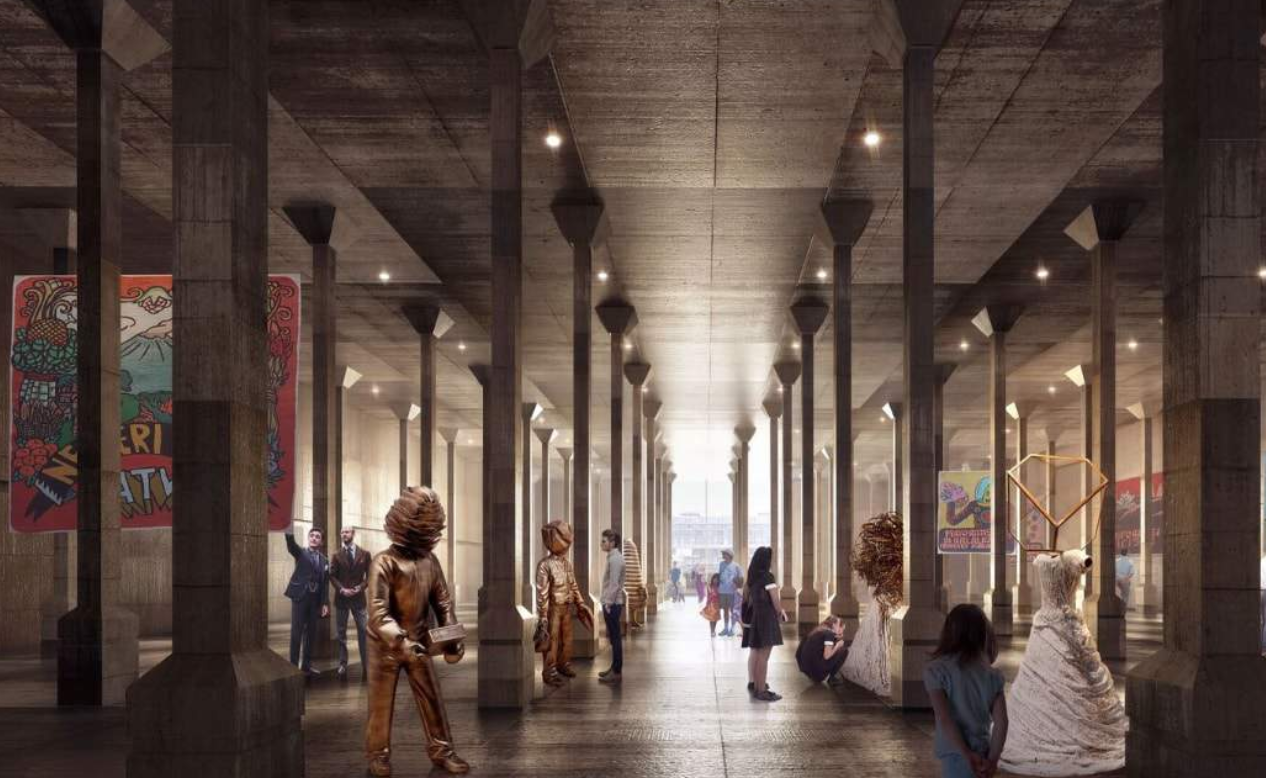
The new Sydney Modern (above), of the Art Gallery of New South Wales, opened on December 3, 2022. Mainstream media went on a bender and the Premier, Dominic Perrottet, declared it “the most significant cultural build since the Opera House”. Journalists should have known better than to mistake Sydney Modern for an era-changing masterpiece. Former Prime Minister Paul Keating warned in 2015 that Sydney Modern was going to be “a large entertainment space and special events complex masquerading as an art gallery”—for once he was right.
Philip Drew appears regularly in Quadrant.
Click here to subscribe
Sydney Modern is much too important to be left to dilettante journalists. It will be on our hands for a long, long time as a folly and liability. An architectural “folly” is defined as:
A costly but useless structure built to satisfy a whim of some eccentric, thought to show his folly; usually a tower or a sham Gothic or classical ruin in a landscaped park intended to enhance the view or picturesque effect.[1]
SANAA, a Tokyo-based partnership founded by Kazuyo Sejima and Ryue Nishizawa, is famed for its mannerist interpretation of modern architecture, an illusionist aesthetic of “there, but not there”, of phantom building. Two developments must be considered: first, the worldwide “Bilbao effect” resulting from the success of Frank Gehry’s 1992 Guggenheim gallery which revived the fortunes of the former rustbelt city Bilbao, which was widely imitated. SANAA’s Louvre-Lens gallery is another example. Second, the shock of military defeat in 1945 on Japanese society which reset the culture after the wholesale destruction of its cities by fire-bombing and nuclear weapons.
The “Bilbao effect” brought a new recognition of the power a single iconic building to publicise a city to the world. Utzon’s Sydney Opera House had this effect on Sydney and Gehry deliberately set out to repeat it at Bilbao.[2] Before this, architecture was a secondary adjunct to art, but after the Bilbao Guggenheim architecture became the main act, with their roles reversed. Architects now traded on the enabling power of technological wizardry to create highly sculptured buildings offering new and exciting experiences. The most recent example is Herzog & Meuron’s extraordinary conversion of a warehouse at Hamburg into the Elbphilharmonie concert hall (below).[3]
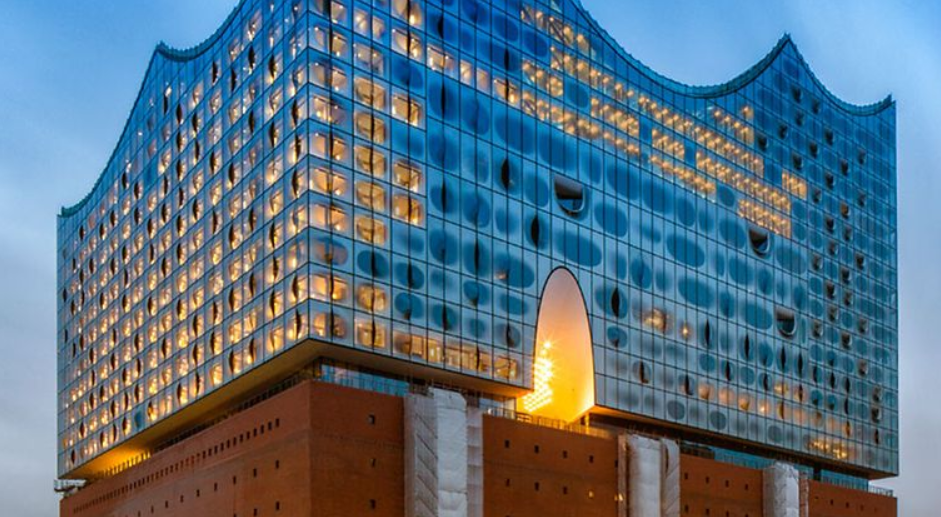
Sydney Modern is typical late-mannerist Japanese architecture. Modernism arrived in Japan via Paris, inspired by Le Corbusier, a Swiss by birth, who painted in the morning and did his architecture in the afternoon. Corbusier was an energetic self-promoter and prolific polemicist for the modernist cause whose work moved from a machine aesthetic in the 1920s to Brutalism in the austere 1950s. Japan’s greatest architect, Kenzo Tange, gave Corbusier’s Brutalist concrete a post-and-beam carpentry interpretation, which was praised for its regionalist values, culminating in 1964 with the stunning Tokyo Olympic swimming and basketball stadia. His successor, Arata Isozaki, inflated Tange’s carpentry post-and-beam style to such size it became his maniera, Italian meaning “manner”. Throughout his career, Isozaki explored numerous manners. The Museum of Modern Art at Gunma (below), north of Tokyo, began an aesthetic of immateriality that exploited shiny reflective metal panels and glass gridded cubes that reduced their visual materiality so that Gunma acquired an aesthetic of ethereal spirituality.
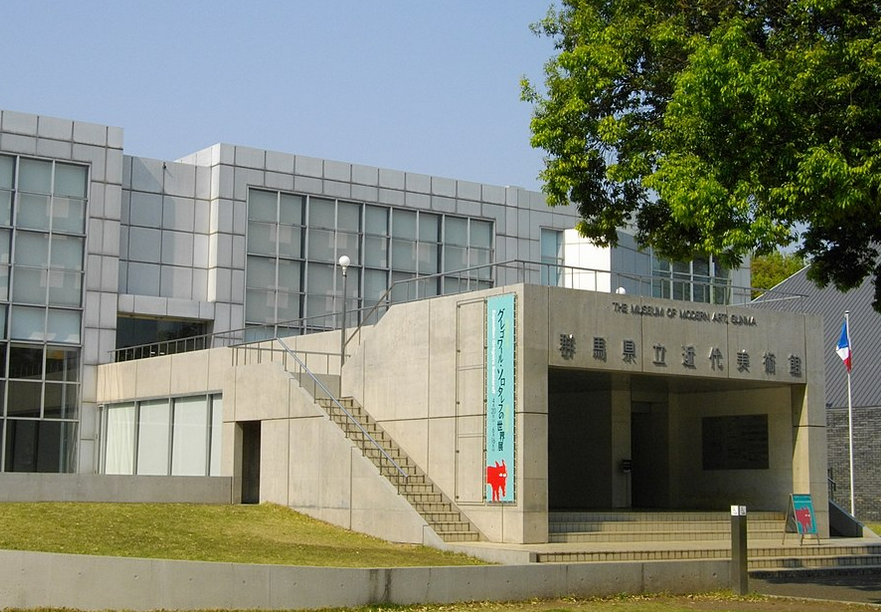
SANAA picked up their signature aesthetic from Isozaki, most recently in Sydney Modern. Before this, and much better, the Musée du Louvre-Lens in 2012 is a regional franchise of the Louvre in Paris which it was hoped would restore the fortunes of the down-at-heel coal-mining industrial city of Lens. SANAA’s style is paradoxical and pretentious to the extent it denies physical materiality and sets out to replace it by a phantom diaphanous luminosity.
Kazuyo Sejima has described his approach—it falls short of a design philosophy—as enhancing the continuity between inside and outside referencing, “how to think about context”. This helps explain, not very convincingly, Sydney Modern, for which four oversized glass boxes—pavilions—were piled on each other at odd angles then opened to reveal a haphazard overlay of roofs. The modern pavilion sprang from Mies van der Rohe’s revival of the Greek temple in steel and glass in 1922. Berlin’s Neue Nationalgalerie in 1968 is a high-modern refined version of Greece’s Parthenon. Sydney Modern has none of Mies van der Rohe’s exquisite sensibility, classical proportions and refined detail. Regardless of where the blame lies, what really matters is the resulting crudity of execution, the buckled steel I-beam framing of the roof, the unfinished bits, graceless glazing, inelegant concrete floor finishes, all of which set one’s teeth on edge. An unexpected bonus is a new recognition of how accomplished and technically refined Vernon’s 1909 building for the Art Gallery of New South Wales is by comparison. Its precise classical details and the loving stone craftmanship are wonderful in the light of Sydney Modern’s failures. And the new Edmund and Joanna Capon Research Library on level three is a revelation as a richly rewarding scholarly retreat.
In 1922 Le Corbusier wrote: “When a problem is properly stated, in our epoch, it inevitably finds its solution.”[4] Little wonder Sydney Modern failed to find a solution—the mission was never properly stated at the beginning. Art today is an enigma, more a question and a collection of uncertainties. For a building to succeed, the requirements must be stated with clarity and precision. It was there that the new Sydney Modern foundered. There was no appreciation of art gallery history as a building type, its development as a walking space for viewing art, from art collected in the Italian Renaissance of classical antiquity to entire genres of contemporary art. Classical sculpture was assembled and displayed in courtyards, loggias and gardens. It was from such walking spaces for the connoisseurs that the modern art museum developed. Later in the cold north, long indoor gallery spaces were provided in chateaus for the display and enjoyment of art.[5]
In the eighteenth century, art became separated from craft. Before this, art and craft were interchangeable, and included “any human activity performed with skill and grace”.[6] In the nineteenth century, architecture lost its prestige and was excluded from museums. Most art histories recognise architecture, but not in the museum. Art gallery directors continue to deny architecture and refuse to include it. MOMA in New York is an exception. Architecture for some time now has become art’s superior and much more in contemporary society because it has retained a connection with everyday economics and life and has enlarged its aesthetic impact by absorbing advances in technology to deliver new and novel experiences. This has placed architecture well ahead of the visual arts and assists in explaining Sydney Modern. When architecture is badly handled and impractical the failure is catastrophic and the entire gallery enterprise is undermined. This is especially so in the present day where architecture serves as a magnet to attract visitors and tourists by offering an “experience”.
Until recently, throughout human history sculpture was inseparable from architecture. Great periods of architecture such as ancient Greece, Roman, Gothic and Renaissance were also great periods of sculpture. And architecture was a home that encouraged the visual arts. When art is distanced from its purpose, its meaning is lost.
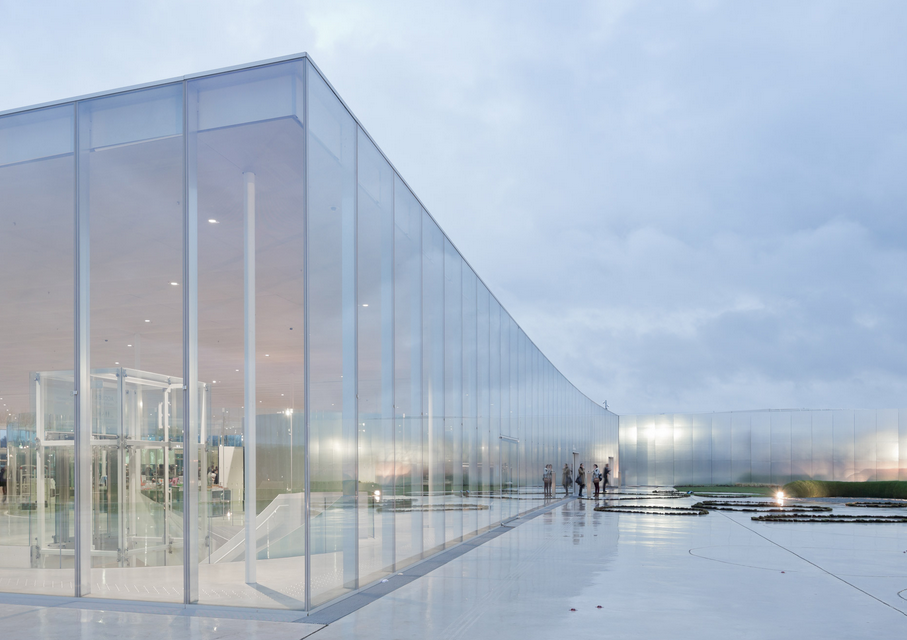
Perhaps the most distressing feature of Sydney Modern is its failure to address climate and sustainability. Since Sydney is not France, the adoption of the Louvre-Lens approach (above) in Sydney which experiences hot humid summers and bright intense sunlight, is likely to prove a disaster. On the north, east and west, floor-to-ceiling glazing is unprotected. Dr Annie Godfrey has noted:
There are two ways of getting a high Green Star rating. One is to build a sustainable building. The other is to spend large amounts of money on green technology and expensive materials with a high embodied carbon, to compensate for bad design … Sydney Modern does the latter, squandering a lot of its $366 million spend of public funds.[7]
The shortcomings of Sydney Modern are obvious: it is far too big, lacks a sense of arrival, and the three lumpy pseudo-Giacometti sculptures further trivialise the space; once inside, the open space is too high and lacks definition, the space for paintings is inadequate, and the oil tank, a survival from the Second World War with genuine character, can only be accessed by a single lift. This is just the beginning! One of the few positives are the pisé sandstone walls on each level that identify the architecture with Sydney’s sandstone geology.[8] They replace the silver reflecting aluminium panel walls of the Louvre-Lens. Helpful as that may be, they do little to dispel the impression Sydney Modern is a corporate function centre on the harbour. The high-fashion style of many of SANAA’s buildings sits perfectly with the requirements of corporate receptions, as in its Dior Building in Tokyo, whose essence is “a show of retail-led exhibitionism”.[9] Sydney Modern plays up the Harbour but disrespects the nearby Royal Botanic Garden.
SANAA is not first to explore the interplay between building and landscape on an inspiring site. At the beginning of the twentieth century in America, Frank Lloyd Wright broke down the barrier between interior and landscape. From this, the modern pavilion stepped forward offering a solution. Many ways exist, some subtle, some crude, such as Philip Johnson’s nakedly obvious Glass House in New Canaan. Few of them possess the dazzling sophistication of Jørgen Bo and Vilhelm Wohlert’s Louisiana Museum in Denmark, at Humlebæk, sited on a gentle slope looking out across Øresund. The location is similar to Sydney Modern on a more intimate scale. There is an immediate obvious difference in as much as Sydney Modern suffers from too much building. Everything about it, internally and on the outside is big, the interiors are inflated and vacuous—much too large for where they are—resulting in hostile massing that overwhelms. Its raw geometrically abstract terraces do little to mitigate the effect of its intrusive forms that dominate everything around them. And the scale is terribly wrong.
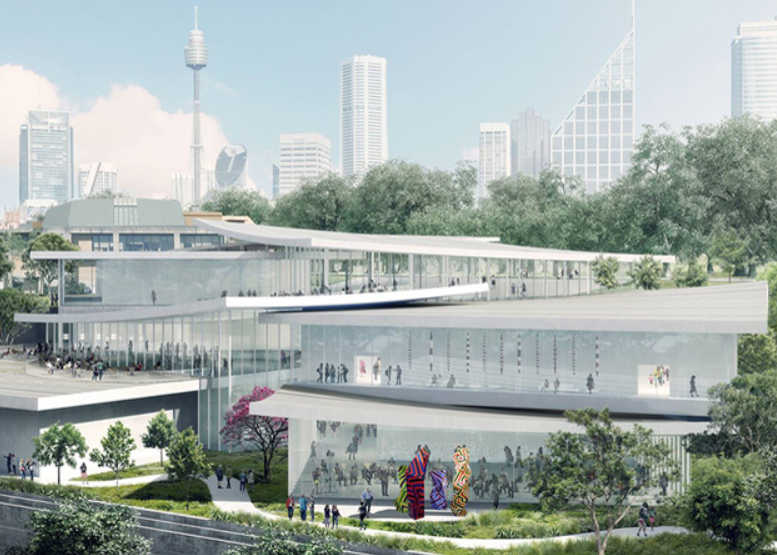
The Louisiana Museum contains many valuable lessons, which, unfortunately, were missed in Sydney. Bo and Wohlert staggered the walkway, leaving gaps that capture and borrow landscape. You never see it all at once, the pavilions en masse. Instead, the halls are separated and have an inviting human scale with restful landscape views in between that clean the visual palate. Nor does the architecture overpower as in Sydney, but instead offers an engaging richly varied experience, humming with quickly changing exhibits. The scale is right—just right—unlike the huge empty spaces at Sydney Modern that engulf and reduce small works to insignificance. Louisiana is everything Sydney Modern is not: its white-bagged brickwork and stained timber unite the relaxed spacious quality of the architecture organically, qualities of modern architecture that in combination with traditional crafts unite building with landscape.
For Sydney Modern the future challenge will be its financial maintenance. In 2021, Dr Michael Brand told Budget Estimates: “Roughly doubling the size of the building does not mean you have to double the size of your staff. There will, of course, be more security, more visitor services and more cleaning, for example.” He omitted to say how this might be accomplished when its staff were asking for an increase in permanent jobs in crucial departments including installation, registration, curatorial, conservation, public programs and education.[10] Not surprisingly, the gallery has received criticism for being “in slow motion when it comes to exhibitions, with catalogues and openings chopped and staff herded into open plan offices while the executive elite have private offices”.
While art galleries are really walking spaces or verandas, Sydney Modern’s overbearing stark pavilions force people onto escalators to get from floor to floor, interrupting continuity. The “glass pavilion” idea is a century old and is no longer fresh. When Mies van der Rohe designed the Nue Nationalgalerie, Berlin, he recognised the limitations of the open glass pavilion and sensibly provided a suitable exhibition space for visual art works in the museum’s basement.
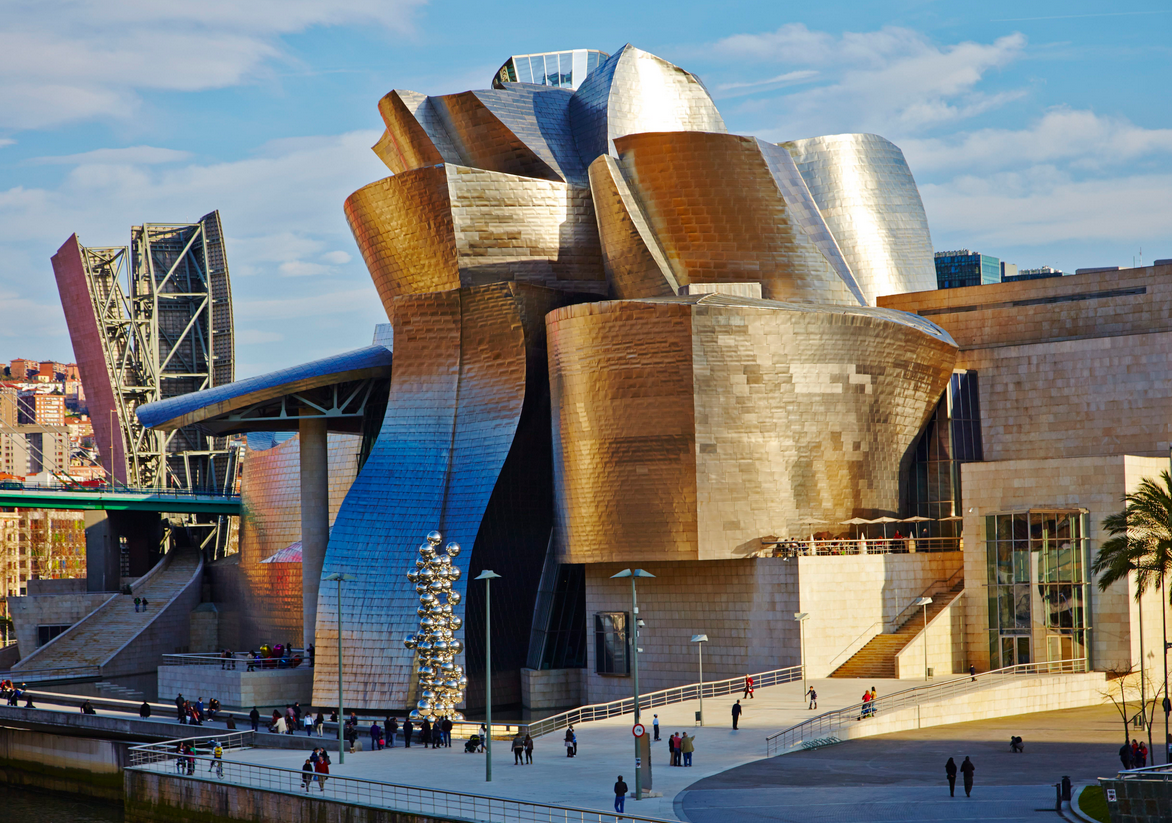
Throughout history a single building type was favoured. In the neolithic age it was stone ring henges, in Egypt the pyramid, in Rome amphitheatres, in the medieval period, castles and cathedrals. The nineteenth century built museums, and after the Second World War it was concert halls. The 1990s produced a wave of new art museums, and the Guggenheim at Bilbao (above) in 1997 provoked a wave of franchised regional offshoots. Sydney Modern then NGV Contemporary should be viewed as late-arriving ripples of the phenomenon. The contrast presented by them, in terms of design thought, could hardly be greater and less favourable: Sydney Modern ranks at the bottom as SANAA’s worst building; NGV by an Australian architect promises to be an original Melbourne icon that will surely grab the attention of the world when it is completed.
Sydney and Melbourne are very different cities and reflect important differences between their state governments: New South Wales approached the task in an ad hoc manner without researching what was needed, or what it wanted to achieve. Victoria allocated $1.7 billion for a Melbourne Arts Precinct Transformation and Lindsay Fox jumped in with a $100 million contribution to set the ball rolling.
The NGV-Contemporary design emerged from a traditional two-stage competition among twenty firms, with Sydney firm, Candalepas and Associates, the winner. The site at the rear of the existing Roy Grounds building has none of the landscape gifts enjoyed by Sydney Modern, which overlooks Sydney Harbour and enjoys stunning vistas of Sydney Heads. The NGV-Contemporary site is hemmed in by buildings and claustrophobic. Where Sydney Modern is extroverted and outward, NGV is introverted and inward and focused on its central volume. Each reflects and is a response to climate.
The first thing to know about Angelo Candalepas is he is Greek. His father arrived from Greece in 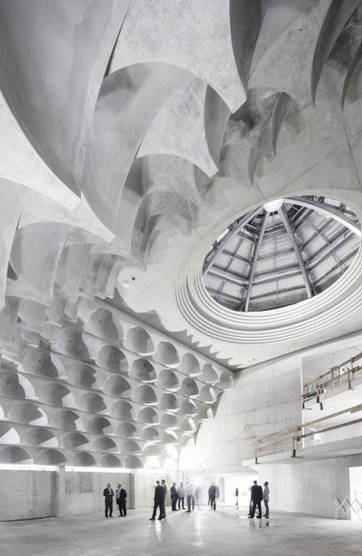 the 1950s and his first action was to restore a derelict Greek Orthodox church. Angelo inherited his father’s religiosity, and this should go down well with Melbourne’s large Greek community.
the 1950s and his first action was to restore a derelict Greek Orthodox church. Angelo inherited his father’s religiosity, and this should go down well with Melbourne’s large Greek community.
His buildings are scattered around Sydney, and he is no longer a youngster, but Candalepas shot to international acclaim with the Punchbowl Mosque (right). He is an admirer of the American architect Louis Kahn, a Latvian Jew, who settled in Philadelphia. Louis Kahn was obsessed by geometry and the Western classical canon. Candalepas inherited Kahn’s bias, in particular, the intense focus on detail perfection building organically towards a whole.
One jury member, Jill Garner, promised: “The NGV-Contemporary will be an intriguing new landmark showcasing how architecture can respond to and enhance the rich and diverse cultural historical life of our city.” Nor did NGV go overseas to find it.
Much like centralised Renaissance churches, NGV’s Contemporary art gallery has a central space around which everything hangs to orientate arriving visitors. Sydney Modern’s central space uniting its four levels seems fortuitous and uncoordinated, ragged and diffuse, the opposite of the NGV’s forty-metre-high dizzying vertical spiral. In Sydney Modern, the visitor looks up through a series of haphazardly arrayed overlapping curved surfaces that lack a sensible form and seem a pure accident. The same space in NGV resembles the inside of an intriguing giant pot.

Candalepas thinks of it as an omphalos, Greek for navel of the earth. During a performance of Medea by Maria Callas, two eagles were seen to clash in the sky high above the audience. Time stopped. It was as though the legend of Zeus dispatching two eagles from either end of the cosmos to determine the centre of the earth was being re-enacted.[11] Watchers saw one eagle fall out of the sky, its wings flailing. Legend has it that two eagles dispatched by Zeus met at Delphi between the two cliffs of the Phaedriades (“shining ones”) which a mighty earthquake had split in two. Melbourne is hardly Delphi, but the new NGV-Contemporary (above) carries a similar transformative symbolic message. Australia already has a well-recognised navel, the red rock dome at Yulara which marks Australia’s geographical centre. Sydney can rightly claim to be the birthplace of British Australia, but Melbourne’s new navel will add to its already formidable cultural prestige.
Besides Kahn there is something much deeper if Candalepas’s architecture is to be understood more fully, and that is the flavour of Byzantium, which informs his attachment to elaborate domical forms and simple ordered graciousness. This is the second time Candalepas has invested a central space with uplifting glowing sanctity. The first was the mosque at Punchbowl. It doesn’t quite work there, undermined by the dome’s eccentric placement half over the women’s section. NGV is more elaborate and has two chambers one above the other, with an oculus opening between them through which the upper spiral gallery (a version of Wright’s celebrated 1959 Guggenheim Gallery in New York) is viewed, lit from above by a lantern.
Byzantium left a legacy that did not disappear but evolved under the Ottomans and found its way into Greek culture across the eastern Mediterranean. There are traces in Candalepas. In the 1950s, Lawrence Durrell detected a distillate of Byzantium in Dodecanese peasant culture in Cyprus:
For Byzantine culture was something more than the sum of its elements. It drew from languishing Hellenism and the influences of the Near East. It was an entity, not merely a colourful composite made up of assorted fragments of different cultures.[12]
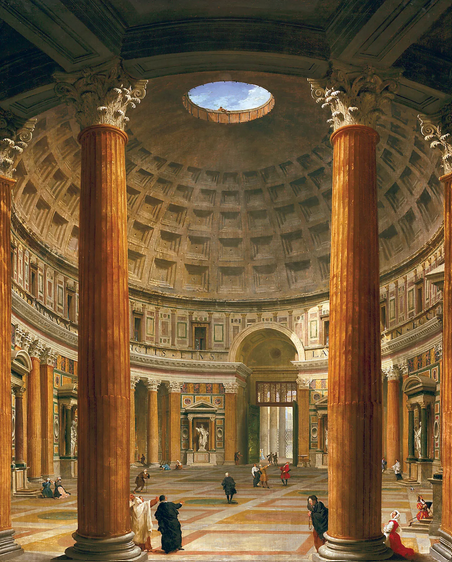 The Roman solution to spanning large interior spaces was the perfectly hemispherical dome which became an essential customary feature in early Christian architecture and lived on and flourished in eastern Byzantine architecture. The most impressive Roman example is the Pantheon in Rome (left), begun in 117 and dedicated in 128 under Hadrian as the “temple of the whole world”. It has the shape of a sphere within a cube, symbolising the Roman cosmos with Rome at the centre, and is a model of heaven. The hemispherical upper half has an eye oculus opening that casts a shaft of sunlight throughout the day that slowly moves cross the floor. Constantinople’s Hagia Sophia, four hundred years later in 528, repeated the trick.
The Roman solution to spanning large interior spaces was the perfectly hemispherical dome which became an essential customary feature in early Christian architecture and lived on and flourished in eastern Byzantine architecture. The most impressive Roman example is the Pantheon in Rome (left), begun in 117 and dedicated in 128 under Hadrian as the “temple of the whole world”. It has the shape of a sphere within a cube, symbolising the Roman cosmos with Rome at the centre, and is a model of heaven. The hemispherical upper half has an eye oculus opening that casts a shaft of sunlight throughout the day that slowly moves cross the floor. Constantinople’s Hagia Sophia, four hundred years later in 528, repeated the trick.
Punchbowl’s mosque cupola is a pseudo-dome assembled from precast units that emulate the cellular squinches in Islamic architecture. For NGV-Contemporary, Candalepas inserted a plasticly extended composite dome inside a large cuneiform block form. It is an immensely impressive hollow space within a solid, invisible externally, and a great surprise to people entering the gallery. A mystery upright Aladdin cave encased and surrounded by exhibition galleries, with an expansive rooftop terrace and sculpture garden from which can be seen stunning vistas of Melbourne. On the eastern facade there is a multi-level veranda doubling as an external pathway connection between levels.
Each year when I was an architecture student, we decided which were the ugliest new buildings in Sydney and gave them a rhinoceros stamp.[13] Sydney Modern deserves the “rhinoceros 2022” stamp, while the NGV-Contemporary, fully deserves a Phillip Adams “koala stamp with gumleaf cluster” as Australia’s most promising starter in 2022.
Philip Drew is an architectural historian and critic based in Sydney
[1] John Fleming, Hugh Honour, Nikolaus Pevsner, The Penguin Dictionary of Architecture, Penguin Books, Harmondsworth UK, 1972, p. 100.
[2] ‘Playboy Interview: Frank Gehry’, Playboy, January 2011, p. 44: “When initially I met with the clients in Bilbao—the people who represented the city—they asked for the Sydney Opera House. That is they wanted something that would define Bilbao the people of in the way the Opera House defines Sydney. In my own way I delivered what they asked for.” The publication of the Gehry interview in an adult magazine such as Playboy which exploits sex is itself interesting and suggests Gehry’s architectural sculpture approach was viewed as ‘sexy’. The Guggenheim Bilbao Museum was the setting for the opening scene of the James Bond movie, The World is Not Enough, and is further proof. See also, Witold Rybozynski, ‘The Bilbao Effect’, The Atlantic, September 2002.
[3] The use of glass sculpturally is a special design feature of the Elbphilharmonie, like the Sydney Opera House, eventually cost far more than the estimated €200 M rising to €866 M but delivered a spectacular acoustic hall seating 2,100.
[4] Le Corbusier, Towards a New Architecture, translated by Fredrick Etchells The Architectural Press, London, 1970, p. 102
[5] Nikolaus Pevsner, A History of building Types, Thames & Hudson, London, 1976, p. 111, explains this in detail including the use of ‘museum’.
[6] See Mark Roberts, ‘Let’s Abolish ‘Art!’, Aesthetics: The Philosophy of Art, Beauty and Taste, The Ultimate Guide, Issue 5, Philosophy Now, London, 2022, p. 8.
[7] Annie Godfrey, ‘Sydney Migraine”, Cultural Heist. Com.au, online edited by Judith White. The announced final cost as announced is $344 million, $244 million funded by the NSW Coalition Government. This does not include $71 million from recurrent funding for 2023, of $39.5 million, reducing funding for operational costs to $41 million shared by the two buildings not taking into account Sydney Modern it twice the size of the south Vernon Building.
[8] Pisé is a rammed-earth method of construction. In this instance the consisted of crushed sandstone from the excavation between shutters. The dense, hard walls thus obtained are similar in appearance to walls of soft sandstone. See, Pisé Construction, Notes on the Science of Building, NSB. 18, Commonwealth Experimental Building Station, June 1964.
[9] Norman Day, ‘New NGV building a ‘beige, bland, gaudy show of retail-led exhibitionism’, The Age, December 8, 2022.
[10] Judith White, ‘Sydney Modern: the ultimate cultural cringe, Cultural Heist.com.au, online.
[11] Evi Melas (Ed.), Temples and Sanctuaries of Ancient Greece: A Companion, Thames & Hudson, London, 1973, 59-60
[12] Lawrence Durrell, Bitter Lemons, Faber and Faber, London, 1957, p. 121.
[13] Our small group of Anarchists in the Government Architects Department of the NSW Public works Department was led by Frank William Turner (Bill) in Hospitals. He had served as a bombardier in the RAF over Europe after e disgraced himself by landing his fighter across the runway. With Bill’s direction we pasted prints of Durer’s rhinoceros on the shamed buildings.
 Sign In
Sign In 0 Items (
0 Items ( Search
Search










In the Sydney Modern we have a prime example as architecture reduced to ‘walk-in sculpture’. And that is not a compliment; when it should be shelter that brings socially meaningful representation and connects us with place and time. The bunker does a better job at this than the indulgent confection above.
On reflection, my use of the word ‘socially’ sounds almost Marxist. Not so. I mean simply as being meaningful to people in terms of social relations…and we are always acting in such terms, being inherently and unavoidably dependent upon others…socially, mediated by the production and exchange of value in free exchange. Many values are uneconomical, being personal, and many exchanges occur without monetary exchange, just to clarify.
“Forms are beautiful, the perfect being is beautiful, and among these forms, the form of good is the most beautiful”. Plato .
“Thomas Aquinas thought of beauty as a kind of transcendental”. I guess this could be thought of as true beauty.
The architecture of the modern age reflects a base notion of beauty that lacks spirit- the secularising economy of the age!
To take on the title ‘the worst new building in Sydney’ is to be spoilt for choice. As someone who frequents the western distributor, I am daily confronted by what is an insult to Sydney residents – a massive building with no aesthetic or taste which was obviously gifted to us by someone who can work a computer.
And, in the verbose technical analysis whereby the author confers some gravitas on patently ugly buildings, it becomes clearer how untalented our modern artists and architects are and how much they are propped up by careerists who discover ‘Renaissance centralised churches’ in buildings that are laughable in comparison to any Renaissance artist or architect.
Just read about how Brunelleschi designed his Dome in the (beautiful) Duomo, or look at the architecture produced by Michelangelo the sculptor. But please don’t insult our intelligence by some progressivism whereby we are expected to engage in the great pretence that the modern ‘artist’ can draw or the modern ‘architect’ has designed a building that acknowledges a single human need or caters to any desire for beauty at all.